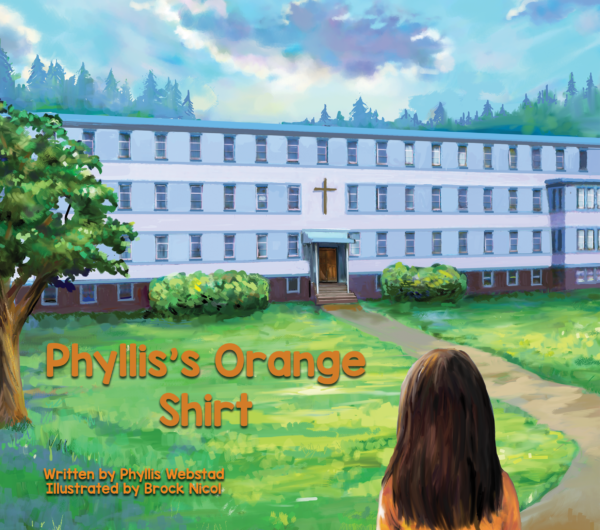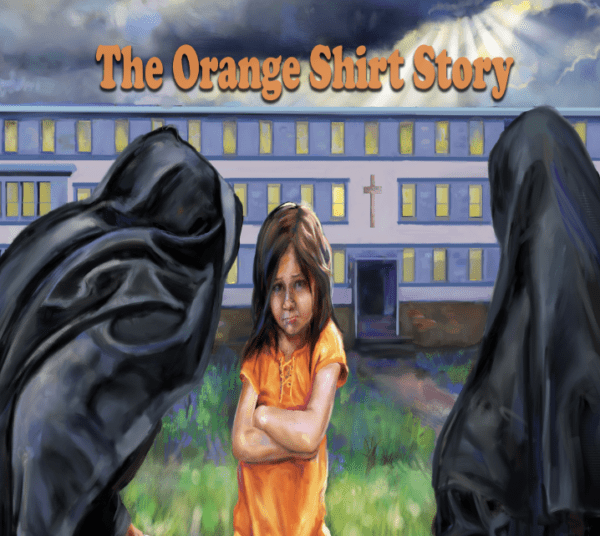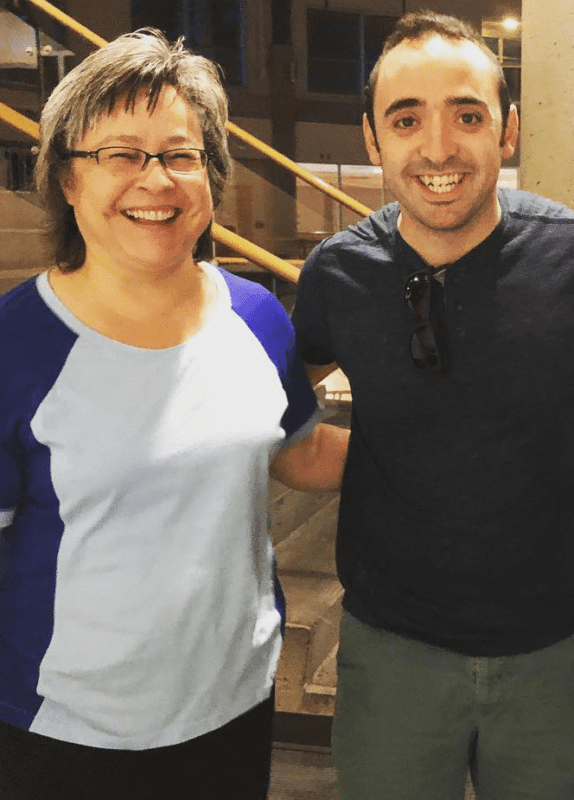 On Orange Shirt Day (Sept. 30th), kids across Canada will once again take part in activities to honour residential school survivors. Many will read or have read to them the 2018 book, The Orange Shirt Story (for ages 6–8), and this year a new book, Phyllis’s Orange Shirt, has been released for even younger children (4–6). Both books are written by Phyllis Webstad – based on her childhood experience of going to residential school in a brand new orange shirt and having it taken away from her by nuns – and illustrated by Brock Nichol.
On Orange Shirt Day (Sept. 30th), kids across Canada will once again take part in activities to honour residential school survivors. Many will read or have read to them the 2018 book, The Orange Shirt Story (for ages 6–8), and this year a new book, Phyllis’s Orange Shirt, has been released for even younger children (4–6). Both books are written by Phyllis Webstad – based on her childhood experience of going to residential school in a brand new orange shirt and having it taken away from her by nuns – and illustrated by Brock Nichol.
Medicine Wheel Education, founded by Teddy Anderson, is the small Victoria publisher that Webstad entrusted her story with. “I didn’t have a manuscript, the story was in my head and heart,” says Webstad. “No publisher would work with me unless I had a manuscript. But Teddy had helped other elders with their oral stories and he knew exactly what to do.” Anderson, who is not Indigenous, grew up in Red Deer, Alta., studied hoop dance, has been adopted into the Tagish/Carcross First Nations, and belongs to the Deishitaan clan. Q&Q spoke with Anderson about how the books came to be and the impact they’re having on children in this country.
How did you come to publish the original Orange Shirt Story?
We realized that although people knew the importance of Orange Shirt Day, very few understood the details of what happened to Phyllis, including myself. Phyllis reached out to me to see if I was interested in publishing her story. She had very little hope as her story had already been rejected twice by other publishers and a third publisher told Phyllis to change her residential experience as if she was a scared little girl going camping. After a brief conversation with Phyllis I realized having her share her story in her own way helps us all connect to the reality of what she faced and gives us a glimpse into the reality of other residential school survivors and their families. It is critical for all Canadians to understand our past in order to build a positive future together.
What led Medicine Wheel to then make a younger version of the story, Phyllis’s Orange Shirt?
There was feedback from Kindergarten to Grade 1 teachers that they really wanted a resource to teach about Orange Shirt Day authentically. We wanted to ease children into this difficult topic in a way that is age appropriate. Now four-year-old children can learn some aspects of Phyllis’s story without being overwhelmed.
What specific changes were made?
Phyllis and I were both in complete agreement that we do not want to overwhelm or traumatize children. We want to offer age-appropriate facts and inspire the reader to empathize and connect with the story. In Phyllis’s Orange Shirt we changed four images to make them lighter and more gentle all with Phyllis’s guidance. We had to tread carefully as we did not want to numb her voice but rather express it to a younger audience in a real way. The story was also changed into a rhyming scheme to make it more inviting and appealing to a younger reader.

In your view, how has Phyllis’s story and these books changed/impacted this country?
Phyllis’s story is giving all Canadians a chance to right the wrongs of our past. We have a very dark history and Phyllis’s story is important for all to understand because we all feel the impacts of the residential school system whether directly or indirectly. I truly feel the next generation already understands the need to spread the message that “Every Child Matters.” When you ask an adult in this country some will know about Orange Shirt Day and others will not. But when you ask students from across Canada they know what it means. The next generation is being educated about topics that we silenced for such a long time. We are breaking attitudes, patterns, and essentially behaviours that led to the residential school system. I can’t wait for what this country will look like in 10 or even 20 years when these students grow up to become our future leaders, doctors, lawyers, etc…
Both books topped the most recent CBC bestsellers list for children. What does it mean to you?
To be honest we never expected to be on the list. We just tried and did our best to deliver authentic First Nations stories to our audience while empowering our First Nations storytellers. To us it means that our country is ready for change and to move forward in positive ways. It means a lot of people have open hearts and are ready to move forward in a positive direction. We are such a little company with very few resources but we have a huge heart. From the beginning we decided to do things in a good way respecting our authors, taking care of them, and making sure we treat their stories not as a product but as sacred. My belief is our authors feel that.
Beyond Webstad’s stories, you’ve made other pairs of Indigenous books for children – one version for kids 6–8 and then an adaptation for younger children. What is your goal in publishing these books?
First, we want to create a safe space for people (teachers, parents, and children) to learn about First Nations cultures in authentic and meaningful ways. We also want to help storytellers make the transition to become writers of children’s books. In cultural history a lot of Indigenous stories were told through oral tradition which is powerful and beautiful. We wanted to help these oral storytellers transition their stories into book form reaching a much wider audience. Lastly, the goal is unity and understanding. These stories offer more representation in the book world as well as in education. The more we understand each other’s culture the greater and stronger our society will become.
This interview has been edited and condensed for clarity.

Webstad and Anderson
 Contact us via email
Contact us via email

